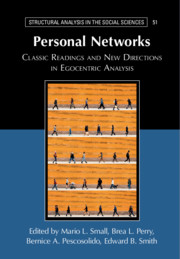Book contents
- Personal Networks
- Structural Analysis in the Social Sciences
- Personal Networks
- Copyright page
- Contents
- Figures
- Tables
- Contributors
- I Background
- II Early Foundations
- III Later Foundations
- IV New Perspectives
- 20 On Cognition
- 21 On Mobilization
- 22 On Trust
- 23 On Dynamics
- 24 On Inequality
- 25 On Culture
- 26 On Migration
- 27 On Movements
- 28 On Social Media
- Index
- Recent Books in the Series
- References
27 - On Movements
The Opportunities and Challenges of Studying Social Movement Ego-Networks: Online and Offline
from IV - New Perspectives
Published online by Cambridge University Press: 01 October 2021
- Personal Networks
- Structural Analysis in the Social Sciences
- Personal Networks
- Copyright page
- Contents
- Figures
- Tables
- Contributors
- I Background
- II Early Foundations
- III Later Foundations
- IV New Perspectives
- 20 On Cognition
- 21 On Mobilization
- 22 On Trust
- 23 On Dynamics
- 24 On Inequality
- 25 On Culture
- 26 On Migration
- 27 On Movements
- 28 On Social Media
- Index
- Recent Books in the Series
- References
Summary
Protest is ubiquitous in contemporary societies, as is illustrated by any review of recent news headlines. Tarrow and Meyer (1998) refer to the proliferation of protest and its diffusion into everyday life as characteristics of "the social movement society." Social networks are integral to understanding social movement processes. This chapter provides a broad overview of the SNA methodological toolkit, with a focus on ego-networks, so that social movements scholars better understand how networks shape social movement recruitment and support, communication, and social-political influence. The chapter is structured as followed. First, we provide a contextual overview of research on networks, collective action and social movements that underlines the importance of SNA approaches to social movement research. Second, we introduce a set of standard ego-network approaches to social movements and discuss some of the attendant challenges of these approaches. Third, we discuss less well-established qualitative and mixed-methods network approaches to social movements research. Fourth, we describe and discuss some consideration relevant to conducting longitudinal social network analysis, and modeling network dynamics. Finally, we discuss virtual networks as sources of social movements data collection and analysis.
Keywords
- Type
- Chapter
- Information
- Personal NetworksClassic Readings and New Directions in Egocentric Analysis, pp. 696 - 717Publisher: Cambridge University PressPrint publication year: 2021
References
- 3
- Cited by



